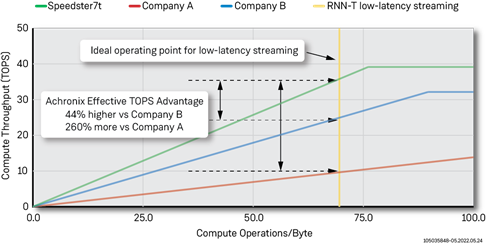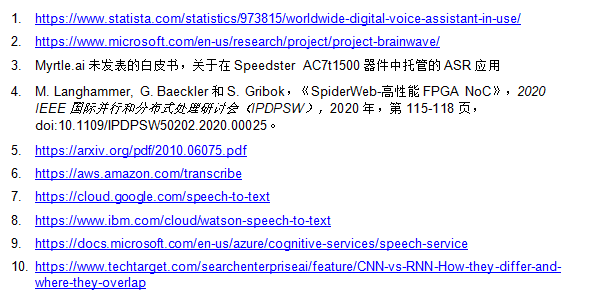
Figure 4: 2D NoC with 20 Tbps total bandwidth
Unlike competing solutions, the 2D NoC eliminates any bottlenecks between the memory and compute engines in the Speedster7t ASR solution, enabling optimal utilization of the hardware accelerators at these very low batch rates.
Putting all of these features together in a roofline diagram clearly illustrates the advantages of the Achronix Speedster7t devices over other competing FPGA solutions in low-latency ASR applications. The roofline diagram uses verified TOPS data published by each manufacturer to show what these devices can achieve in real-world applications.
The figure below shows a roofline model of effective TOPS using a subset of the code built by Achronix for microbenchmarks (GEMV and MLP) and tests, as well as published data from Company A [4] [5] and Company B (based on the architecture). The orange vertical line represents the sweet spot for batch sizes of 8 ms and 80 ms for audio blocks used in low latency, real-time ASR data streaming applications. At this sweet spot, Achronix achieves a 44% improvement in effective TOPS over Company A and a 260% improvement over Company B’s solution.

Figure 5: Roofline model of effective TOPS
Achieve a 90% reduction in ASR processing costs within one year
Most ASR solutions are provided by large cloud service providers such as Google, Amazon, Microsoft Azure, and Oracle. As operations scale and these products become more successful in the market, service providers building products on top of these cloud APIs face increasing cost pressures. Larger ASR providers publicly advertise costs ranging from $0.01 to $0.025 per minute [6], [7], [8], [9]. Industry reports indicate that the average call time in a call center is approximately 5 minutes. Consider a large enterprise data or call center service company that handles 50,000 calls per day, each lasting 5 minutes. Using these rates, the ASR processing cost would be $1,500 to $6,000 per day or $500,000 to $2 million per year. Solutions from Achronix and Myrtle.ai can support 4,000 RTS on a single accelerator card, which can handle over a million calls per day.
There are many factors that determine the cost of a standalone ASR device. In this specific example, let’s assume that the Achronix ASR acceleration solution is delivered via an FPGA-based PCIe card and integrated into a 2U server based on an x86 architecture. This device might be sold from a system integrator for $50,000, and the annual cost of running the server might be twice that. This would bring the first year cost of an on-premises ASR device to $100,000. Comparing this on-premises solution to a cloud API service, the end user could save 5 to 20 times the cost in the first year.
Table 1: Summary of comparison between Achronix ASR solution and cloud API service

The highly compact system enables enterprises to scale as their business grows without having to rely on increasingly expensive ASR cloud APIs or build out massive data center infrastructure to deliver on-premises solutions.
Summarize
The ASR function in CAI requires low-latency, high-throughput computation for RNN machine learning algorithms, which challenges modern AI accelerators. FPGA hardware accelerators that claim to have inference speeds of up to 150 TOPS encounter bottlenecks when transferring data between large computing engines and high-speed memories. These bottlenecks can cause hardware utilization to be as low as 5%. Achronix and Myrtle.ai have joined forces to launch an ASR platform consisting of a 200W, x16 PCIe Gen4 accelerator card and related software that can support up to 4,000 RTS simultaneously and process up to 1 million 5-minute transcription files every 24 hours. Comparing the cost of a PCIe accelerator card on a single x86 server to the cost of a cloud ASR service, the first year's capital expenditure (CAPEX) and operating cost (OPEX) can be reduced by up to 90%.
References:

Previous article:Habana Gaudi2 outperforms NVIDIA A100, helping to achieve efficient AI training
Next article:Codasip Joins Intel Pathfinder for RISC-V Design Support Program
- Popular Resources
- Popular amplifiers
- Huawei's Strategic Department Director Gai Gang: The cumulative installed base of open source Euler operating system exceeds 10 million sets
- Analysis of the application of several common contact parts in high-voltage connectors of new energy vehicles
- Wiring harness durability test and contact voltage drop test method
- Sn-doped CuO nanostructure-based ethanol gas sensor for real-time drunk driving detection in vehicles
- Design considerations for automotive battery wiring harness
- Do you know all the various motors commonly used in automotive electronics?
- What are the functions of the Internet of Vehicles? What are the uses and benefits of the Internet of Vehicles?
- Power Inverter - A critical safety system for electric vehicles
- Analysis of the information security mechanism of AUTOSAR, the automotive embedded software framework
 Professor at Beihang University, dedicated to promoting microcontrollers and embedded systems for over 20 years.
Professor at Beihang University, dedicated to promoting microcontrollers and embedded systems for over 20 years.
- Innolux's intelligent steer-by-wire solution makes cars smarter and safer
- 8051 MCU - Parity Check
- How to efficiently balance the sensitivity of tactile sensing interfaces
- What should I do if the servo motor shakes? What causes the servo motor to shake quickly?
- 【Brushless Motor】Analysis of three-phase BLDC motor and sharing of two popular development boards
- Midea Industrial Technology's subsidiaries Clou Electronics and Hekang New Energy jointly appeared at the Munich Battery Energy Storage Exhibition and Solar Energy Exhibition
- Guoxin Sichen | Application of ferroelectric memory PB85RS2MC in power battery management, with a capacity of 2M
- Analysis of common faults of frequency converter
- In a head-on competition with Qualcomm, what kind of cockpit products has Intel come up with?
- Dalian Rongke's all-vanadium liquid flow battery energy storage equipment industrialization project has entered the sprint stage before production
- Allegro MicroSystems Introduces Advanced Magnetic and Inductive Position Sensing Solutions at Electronica 2024
- Car key in the left hand, liveness detection radar in the right hand, UWB is imperative for cars!
- After a decade of rapid development, domestic CIS has entered the market
- Aegis Dagger Battery + Thor EM-i Super Hybrid, Geely New Energy has thrown out two "king bombs"
- A brief discussion on functional safety - fault, error, and failure
- In the smart car 2.0 cycle, these core industry chains are facing major opportunities!
- The United States and Japan are developing new batteries. CATL faces challenges? How should China's new energy battery industry respond?
- Murata launches high-precision 6-axis inertial sensor for automobiles
- Ford patents pre-charge alarm to help save costs and respond to emergencies
- New real-time microcontroller system from Texas Instruments enables smarter processing in automotive and industrial applications
- When purchasing series resonance, the production process should be taken into consideration
- Help with the problems I encountered with the Gaoyun FPGA clock
- 【GD32E231_DIY】-03: Key recognition framework
- Button battery voltage
- Modern toolbox in KiCad Pcbnew
- 3W Principles of PCB Design
- Punctual Atom
- [BG22-EK4108A Bluetooth Development Kit] Part 1: Unboxing and Simplicity Studio Environment Installation
- After several hours of hard work, the Tesla coil was successfully wound 1
- What are the best power solutions for agricultural drones? Vicor engineers tell you!



 Multi-port and shared memory architecture for high-performance ADAS SoCs
Multi-port and shared memory architecture for high-performance ADAS SoCs Machine Learning: Architecture in the Age of Artificial Intelligence
Machine Learning: Architecture in the Age of Artificial Intelligence












 京公网安备 11010802033920号
京公网安备 11010802033920号